Isaac Collins (printer)
Isaac Collins was a printer, publisher, bookseller and merchant of the early American period. He published the New Jersey Gazette and New Jersey Almanac. He is noted for his 1791 bible, the first family bible published in America.
Isaac Collins | |
|---|---|
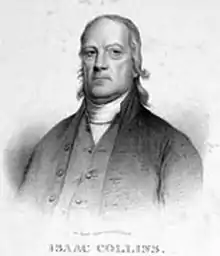 Engraving portrait of Collins at 60 years of age by John Wesley Jarvis, 1806[1] | |
| Born | February 16, 1746 |
| Died | March 21, 1817 (aged 71) |
| Occupation | printer, publisher |
| Parent(s) | Charles Collins and Sarah Hammond |

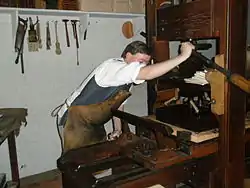
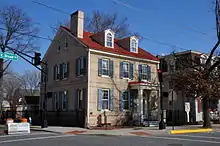
Early life
Collins was born in Centerville, Delaware, on February 16, 1746.[2][3] He was the descendant of English immigrants that died early in their lives.[4] His father was Charles Collins, a wine cooper from Bristol, England,[3] who was an orphan and had immigrated to America in 1734 at the age of nineteen.[2] When Collins's father immigrated to American he debarked at New Castle, Delaware, an area with a large population of Quakers.[2] Collins' father became a farmer in that area (Brandywine Hundred) near the Pennsylvania border and married Sarah Hammond, an English immigrant from Chester County, Pennsylvania.[4][5] Collins had a sister (Elizabeth) who never married and was his only sibling.[5] They were close throughout their lives.[5]
Collins had his primary schooling at the Center Meeting House in Centerville and at Friends' school in Wilmington, Delaware. His upbringing was among the local Quakers, who had a type of religion called "Inner Light".[6] Collins and his sister listened to religious works of authors like Robert Barclay, William Penn, and Isaac Pennington - if they followed the traditions of the local Quakers.[5]
Collins's father had married after Collins's birth mother had died.[7] Shortly after, his father died and his stepmother remarried prior to 1760 and moved to another neighborhood.[7] At this time Collins was put under the guardianship of his mother's brother, John Hammond, who was living in Wilmington.[7] He became indentured under the printer James Adams of Franklin and Hall (Benjamin Franklin's old Philadelphia printing firm, run by his former foreman David Hall) in 1761 to work as a journeyman in the printer trade for five years.[8] Since Adams was his master he furnished Collins with not only printing skills (i.e. inking, closing the press) but was also obligated to furnish him in basic schooling in such subjects as reading, writing and arithmetic.[9]
Adams let go of Collins in early 1766 due to an economic slowdown, when he was twenty years old, completing only four years of his apprenticeship.[10] Collins completed his last year of the 5 year indenture with William Rind, a printer of the Virginia Gazette in Williamsburg.[3][10] He was twenty-one years old in 1767 when he finished his apprenticeship.[11] Collins soon after his birthday moved to Philadelphia to start work as a journeyman printer.[11] He obtained work with William Goddard in the Spring of 1767.[3][12] Collins was accepted as a member of the Philadelphia Monthly Meeting in 1770.[13] In this year he formed a business partnership with Joseph Crukshank.[3][13]
Mid life
Collins decided to do some exploratory trips to Burlington, New Jersey, in the later part of 1770 to check out the feasibility of opening up a print shop there.[14] He decided to move there and became a resident printer, however kept his citizenship ties to Philadelphia.[15] Collins succeeded James Parker as New Jersey's official government printer to King George III.[3][16][17] In that city he started publishing the New Jersey Almanac in 1771 and printed it for twenty-six years continually each year thereafter.[3] He starting publishing the New Jersey Gazette in 1777 being the state's first regular newspaper.[18] [19] [20][21] Collins moved his printing equipment and family to Trenton, New Jersey in 1778 and continued to publish the New Jersey Gazette. Trenton was a more strategic location - a town between New York City and Philadelphia.[22]
Collins was a firm believer in the freedom of the press and had even refused to reveal his source of a pseudonymous article even though the legislative council demanded it.[18] He stood on his grounds as a faithful guardian of the liberty of the press and would not reveal his source unless the source gave him permission.[18] He wrote many persuasive articles on the principle of freedom of the press, including one of particular interest in March 1781 to his friend Governor William Livingston.[18] However Collins had a journalist's viewpoint similar to Benjamin Franklin's in that a publisher had a public responsibility as a "Guardian of his Country's Reputation, and refuse to insert such Writings as may hurt it."[23]
Family
Collins began a courtship relationship with Rachel Budd of Philadelphia in the early part of 1771. As was the Quaker traditions they declared their intentions to get married at monthly meetings, which was done in March and April 1771. They were officially married May 8, 1771.[24] They had fourteen children: Rebecca, Charles, Rachel, Sarah, Elizabeth, Thomas, Susannah, William, Benjamin, Anna, Isaac, Stacy, Mary, and Joseph.[25][16]
Later life
Collins and his wife Rachel moved their family and business to New York City in 1796.[18][26] Their address in the city was on Pearl Street, the location of newspaper publishers John Lang, Archibald McLean, and John Tiebout.[27] Others associated with the printing industry on Pearl Street that Collins patronized were William Durell (paper merchant), John Roberts (engraver), John Bowen (ink-maker), and Peter Meiser (bookbinder).[28] Collins lived in New York City for twelve years.[16] Rachel, his first wife, died in 1805 of yellow fever after it had originally struck New York City at the end of the eighteenth century.[29] Collins moved back to Burlington in 1808. His second marriage was in 1809 to the widow of Benjamin Smith.[16] Her name was Deborah.[16]
The printing firm that Collins started on Pearl Street in New York City was continued by his sons and grandsons.[18] It was claimed for years after Collins left to be the oldest printing firm in New York City.[18] Historian Isaac Thomas claims that Collins was paid 25% more than other printer journeymen because of his acute attention to detail.[4]
Death
Collins died in Burlington, New Jersey, March 21, 1817.[18] He was 71 years old.[30]
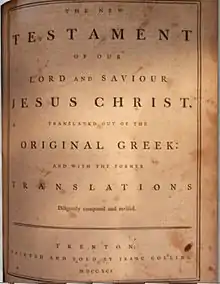
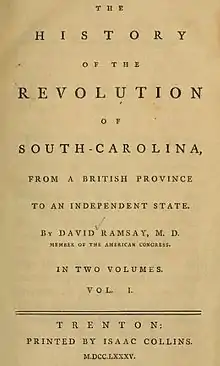
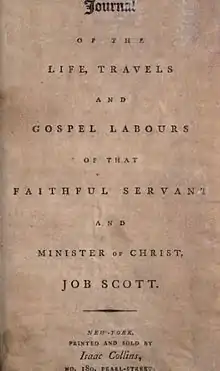
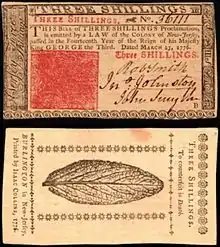
| Wikimedia Commons has media related to Isaac Collins. |
Family bible
It was required in the early part of the 18th century in many of the American colonies that every family have a bible.[3] Most families went by the colony law requirements until the beginning of the American Revolutionary War.[3] Up until this time bibles came from Europe but could no longer be supplied because of hazards of the war.[3] The Continental Congress obtained bids from Collins for producing copies of the bible for the colony families.[3] He published 5000 copies of a quarto edition family bible consisting of 925 pages.[16][18] Collins was paid about four Spanish dollars per bible for the printing.[18] It was the largest publishing job every done in America up to that point.[16] Three thousand bibles were pre-sold with a 25% deposit even before the print job was started.[31]
Collins's bible used higher quality printing types and better techniques than conventional printing of the time period.[16] His bible was proofread up to eleven times before being published.[16] Bible scholars note that it was one of the most textual accurate bibles ever printed.[16][18][21][32] It was the first American family bible published.[33][34][35][36][37]
Works
Some of the works Collins printed and published are:
Newspapers and Almanacs
- New Jersey Gazette (Burlington), Dec. 5, 1777-Feb. 25, 1778
- New Jersey Gazette (Trenton), March 4, 1778-Nov. 27, 1786
- Burlington Almanac (Burlington), 1770-1777
- New Jersey Almanac (Trenton), 1778-1795
Government, other than money notes
- An Act to prevent persons, holding shares of propriety, from cutting timber on the unlocated lands in New Jersey
- Minutes of the Convention of the State of New-Jersey
- Votes and proceedings of various General Assemblies
- Journal of the Proceedings of the Legislative Council
- Acts of the General Assemble of New Jersey
- Constitution of New-Jersey
- Laws of New Jersey
Religious publications
- Journal of the Life, Travels and Gospel Labours of that Faithful Servant and Minister of Christ, Job Scott
- Christian Hymns, Poems, and Spiritual Songs, Sacred to the Praise of God our Savious
- History of the Rise, Increase and Progress of the Christian People called Quakers
- The Holy Bible (KJV), also known as Collins 1791 "Family Bible"
- The Power of Religion on the Mind
- The Saint's Everlasting Rest
- Methodism Displayed
- New Testament 1789
History volumes
- Universal History, ancient and modern; from the earliest records of time, to the general peace of 1801
- The History of Belisarius, the heroik and human Roman General
- The Abbe, Memoirs, Illustrating the History of Jacobinism
- Materials Towards a History of the American Baptists
- The History of Revolution of South Carolina
- The Original and Present State of Man
- The Economy of Human Life
Pamphlets and broadsides
- An Old Looking-Glass for the Laity and Clergy of all Denominations, Who either Give or Receive money under the pretence of the Gospel... Considerations Touching the Likeliest Means to Remove Hirelings Out of the Church of Christ
- A Sonata, sung by a number of young girls ... as General Washington passed under the triumphal arch raised on the bridge at Trenton, April 21, 1789
- Proclamation from Governor Livingston recommending to the people of the United States a day of public thanksgiving and prayer
- A Journal of two visits made to some Nations of Indians on the West Side of the River Ohio, in the years 1772 and 1773
- An Essay on Slavery, Proving from Scripture Its Inconsistency with Humanity and Religion
- Brief Considerations on Slavery, and the Expediency of Its Abolition
- A Compendium of Surveying; or the Surveyor's Pocket Companion
Books
- The Mighty Destroyer Displayed, in some account of the dreadful havock made by the mistaken use as well as abuse of distilled spirituous liquors
- The English Reader; or, Pieces in Prose and Poetry, Selected from the Best Writers
- An Account of the Convincement, Exercises, Services and Travels of Richard Davis
- A Journal, or Historical Account, of the Life, Travels, Sufferings of George Fox
- Directions for the Breeding and Management of Silk-Worms
- Philosophic Solitude: or, the Choice of a Rural Life
- The Instructor: or, Young Man's Companion
- The New England Primer, Improved
- A new guide to the English Tongue
- The Spirit of Masonry
See also
Other colonial printers:
Notes
- Hixson 1968, p. 175 Collins sat for the artist John Wesley Jarvis at his Nassau Street studio on several occasions in 1806.
- Hixson 1968, p. 3.
- White 1926, p. 190.
- Thomas 1874, p. 316.
- Hixson 1968, p. 4.
- Collins 1893, p. 41.
- Hixson 1968, p. 5.
- Hixson 1968, p. 10.
- Angoff 1931, p. 358-359.
- Hixson 1968, p. 11.
- Hixson 1968, p. 14.
- Hixson 1968, p. 16.
- Hixson 1968, p. 18.
- Hixson 1968, p. 23.
- Hixson 1968, p. 24.
- Blake 1859, p. 302.
- Hixson 1968, p. 34.
- White 1926, p. 191.
- Hixson 1968, p. 69.
- Thomas 1874, p. 364.
- Suarez & Woudhuysen 2010, p. 623.
- Hixson 1968, p. 75, 115.
- Hixson 1968, p. 109.
- Hixson 1968, p. 39.
- Hixson 1968, p. 159, 160.
- Hixson 1968, p. 155.
- Hixson 1968, p. 160.
- Hixson 1968, p. 163.
- Hixson 1968, p. 168, 169.
- Thomas 1874, p. 317.
- "Christian Heritage Museum". Christian Heritage. 2013. Retrieved 19 January 2014.
- Hixson 1968, p. 152.
- "The Collins: Bible of Colonial America". www.greatsite.com. Greatsite. 1997–2014. Retrieved 19 January 2014.
- "This is a very rare Isaac Collins Bible, the first "Family Bible" of Colonial America, dated between 1791 and 1824". Anomalos Publishing. 2009. Retrieved 19 January 2014.
- New England Historic Genealogical Society 1892, p. 274.
- Drake 1879, p. 208.
- "History of the Bible Timeline". About.com. A.D. 1791 - The Isaac Collins Bible, the first family Bible (KJV), is printed in America. Retrieved 19 January 2014.
Bibliography
- Memoir of the late Isaac Collins, of Burlington, New Jersey. Philadelphia (Printed by Joseph Rakestraw). 1848.
- Angoff, Charles (1931). A literary history of the American people. A. A. Knopf.
- Blake, John Lauris (1859). A biographical dictionary: comprising a summary account of the lives of the most distinguished persons of all ages, nations, and professions; including more than two thousand articles of American biography. H. Cowperthwait & co.
- Collins, John (1893). Reminiscences of Isaac and Rachel (Budd) Collins: With an Account of Some of Their Descendants, Together with a Genealogy of the Collins Family, and Also a History of a Reunion Held at Philadelphia, May 9, 1892. Lippincott.
- Drake, Francis Samuel (1879). Dictionary of American Biography, Including Men of the Time: Containing Nearly Ten Thousand Notices of Persons of Both Sexes, of Native and Foreign Birth, who Have Been Remarkable, Or Prominently Connected with the Arts, Sciences, Literature, Politics, Or History of the American Continent. Giving Also the Pronunciation of Many of the Foreign and Peculiar American Names, a Key to the Assumed Names of Writers, and a Supplement. J. R. Osgood and Company. pp. 208–.
- Hixson, Richard F. (1968). Isaac Collins: A Quaker Printer in 18th Century America. Rutgers University Press.
- New England Historic Genealogical Society (1892). The New England Historical and Genealogical Register. New England Historic Genealogical Society. pp. 274–.
- Suarez, Michael Felix; Woudhuysen, H. R. (2010). The Oxford Companion to the Book. Oxford University Press. ISBN 978-0-19-860653-6.
- Thomas, Isaiah (1874). The History of Printing in America: With a Biography of Printers, and an Account of Newspapers. To which is Prefixed a Concise View of the Discovery and Progress of the Art in Other Parts of the World. In Two Volumes. From the Press of Isaiah Thomas, jun.
- White, James T. (1926). The National Cyclopedia. New York: James T. White & Company.